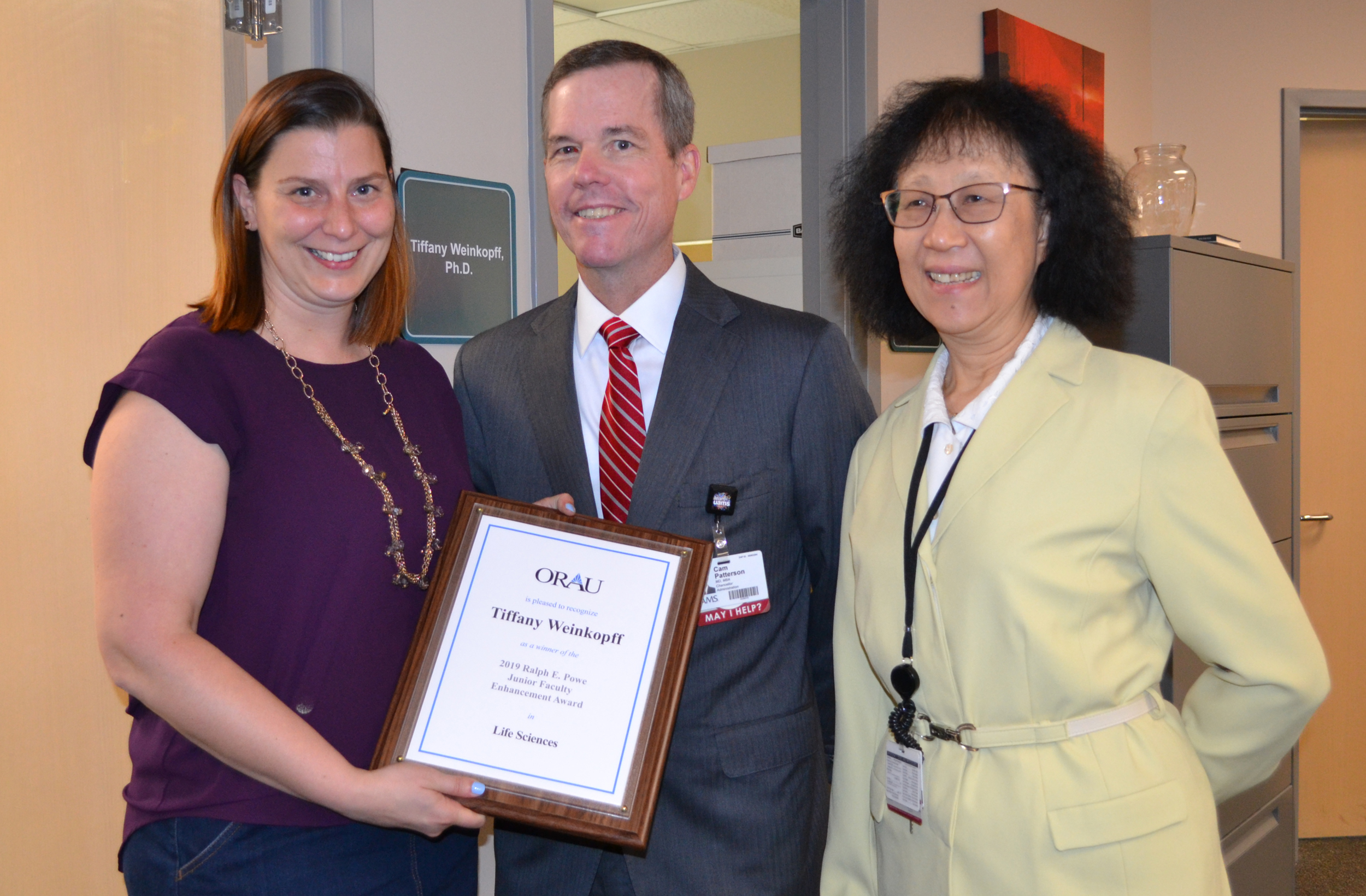Researcher Receives Junior Faculty Enhancement Award from National Consortium
| UAMS researcher Tiffany Weinkopff, Ph.D., has received a 2019 Ralph E. Powe Junior Faculty Enhancement Award, sponsored by Oak Ridge Associated Universities, which recognizes promising new scientific careers and supports their development.
UAMS Chancellor Cam Patterson, M.D., MBA; Vice Chancellor for Research Shuk-Mei Ho, Ph.D.; and Associate Vice Chancellor for Research Lawrence E. Cornett, Ph.D., surprised Weinkopff recently in her office to present the award.
“You were selected from among 167 other applicants in a peer-reviewed evaluation process that included scientists from throughout the nation,” Patterson said. “You’re going to get $5,000 to go toward your research, and we’ve matched that with $5,000 more for a total of $10,000. Congratulations! I see this as validation that other people see your work as we do: as important research at the forefront of medical advancement.”
Weinkopff is an assistant professor in the Department of Microbiology and Immunology in the UAMS College of Medicine. She studies the disease process behind leishmaniasis, an infection spread by parasites that is found in tropical and subtropical regions of the world. Some patients easily heal their skin lesions following infection, while others suffer long-term issues like skin ulcers and destroyed tissue. Some forms of the infection are fatal.
In the body, leishmaniasis causes a massive influx of immune cells to the infection site, dramatic changes to the surrounding blood vessels, and an expansion to the body’s lymphatic network. Weinkopff’s lab hopes to uncover exactly how some of these processes occur at the cellular and molecular level to understand how they might be controlled. They are also studying how the wounds caused by the infection heal.
Surprisingly, when Patterson, Ho and Cornett met Weinkopff, they learned that Patterson worked on the same cells and molecular pathway earlier in his career.
Weinkopff’s work could have implications for treating leishmaniasis and similar diseases. Known as the Neglected Tropical Diseases, they affect more than 1 billion people — or one-sixth of the world’s population — according to the Centers for Disease Control and Prevention. In addition, better understanding the disease process could have applications for treating other types of infection, autoimmune disease and cancer.
“Dr. Weinkopff’s work has the potential to help millions, if not billions of people,” Ho said.
Weinkopff came to UAMS about two years ago. She earned her Ph.D. from the University of Georgia and performed her Ph.D. dissertation work at the Centers for Disease Control and Prevention. She held postdoctoral fellowships at the University of Lausanne in Switzerland and the University of Pennsylvania in Philadelphia.
Shortly after coming to UAMS, she was offered a position in the UAMS Center for Microbial Pathogenesis and Host Inflammatory Responses, directed by Mark Smeltzer, Ph.D. The center has earned $21 million in funding through the NIH’s Centers of Biomedical Research Excellence (COBRE) program, which provides funding and mentoring to researchers who are early in their careers.
“Dr. Weinkopff is the first faculty member from UAMS to receive the Ralph E. Powe Junior Faculty Enhancement Award,” said Cornett, who represents UAMS with the Oak Ridge Associated Universities. “We recruited her to UAMS and got her involved in the COBRE because we think her work could have a significant impact on human health. We are pleased to see that a national organization like the ORAU agrees.”
One of the goals of the COBRE program is to help institutions establish themselves as centers of technology and expertise by attracting promising scientists with adjacent interests to work in the same place, sharing knowledge and tools.
Weinkopff said that a key piece of technology needed for her work, a two-photon microscope that allows her to look at the behavior of cells near the Leishmania infection site in real time, was already at UAMS. She said this two-photon microscope and other COBRE-funded technologies are instrumental in her work. With the Powe grant, she will be able to invest in more of the technology she needs to pursue her research.
“The Powe Award is almost like a pilot seed investment, and by matching the grant, the university shows that it’s behind you as well,” Weinkopff said. “It will help me take this work to the next level and expand into new techniques and technologies.”
UAMS has three COBRE centers, which are launching new scientific careers, attracting top talent and creating concentrations of expertise on topics like infectious diseases, cancer therapy and bone health. UAMS faculty lead two additional COBRE centers on childhood obesity prevention and pediatrics at Arkansas Children’s Research Institute.
The Oak Ridge Associated Universities is a consortium of American universities that aims to advance national priorities and serve the public interest by integrating academic, government and scientific resources globally.
